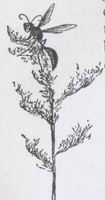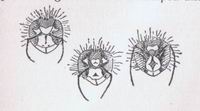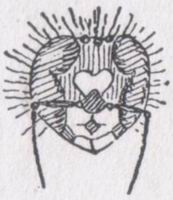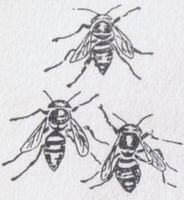|
1999-2004 (Return to Web Text-ures) |
Click Here to return to |
|
1999-2004 (Return to Web Text-ures) |
Click Here to return to |
HAVING EYES, THEY SEE.
ALTHOUGH the Vespae have formed violent attachments to most of us at one time or another, so that we may consider ourselves fairly we'll acquainted with them, our attention has been mainly directed to their sting end and to their general personal appearance.
We know Vespa, but few of us have given much thought to her eyes, though those bright orbs were no doubt responsible for the success with which she attached herself without invitation to our persons.
 Besides the two compound eyes with which we are
all familiar she has a group of three simple ones, which she, like the cyclops,
wears in the middle of her forehead, but which by no means afford her cyclopean
vision. Indeed, many writers deny to them any serviceable function whatever.
They allow them a certain sensitiveness to light, but that is all.
Besides the two compound eyes with which we are
all familiar she has a group of three simple ones, which she, like the cyclops,
wears in the middle of her forehead, but which by no means afford her cyclopean
vision. Indeed, many writers deny to them any serviceable function whatever.
They allow them a certain sensitiveness to light, but that is all.
If it is true, as seems probable, that these three little eyes, or ocelli, are an heirloom from Vespa's distant but very important ancestor the worm, then we can permit her to wear them merely as ornaments, or as glistening reminders of the time when she was a plastic worm with the glorious possibility of becoming a winged and a stinged creature.
But while one so readily accepts the judgment of the scientists on the ocelli, it is another matter when they declare the compound eyes also to be very inferior visual organs; able at the best to give but an impression of light, of color, and of moving objects. The compound eyes of insects are a later development than the ocelli; they are complex in structure and are always present, excepting where the habits of the insect make eyesight unnecessary. They are composed of many simple eyes or facets grouped solidly together. Since these complex eyes have been developed at much cost, it is not unreasonable to conclude they are for purposes of seeing; nor may it be wholly rash to suggest that they may be even better organs of vision than those possessed by man, -- a conclusion our vanity might make it hard for us to accept.
Certainly insects act as if they saw, and saw
well, as when young bees, leaving the hive for the first time, fly close to it
facing it, and do not go away until they have apparently located its position
and learned to recognise it at sight.
Wasps, too, when leaving prey to which they wish to return, act as if they were locating the place, as they fly about carefully examining the neighbourhood before leaving, and when they wish to return are able to find the exact spot, unless meantime some conspicuous landmark has been changed, as by the removal of a large leaf, or a twig, or by the trampling down or cutting away of the grass, when they are as confused as human beings would be under the same circumstances, and sometimes are unable to find the place at all.
Predatory insects, again, have very large eyes, and are able to distinguish the particular insect they want, even at long range.
And any one who has hunted the large fossorial wasps among goldenrod cannot doubt that these wary insects see the approach of their would-be captor.
A tame yellow-jacket kept under a tumbler immediately turned its head and pointed its antennae at the approach of its keeper. Its gesture irresistibly suggested that it had seen the person coming; and the performances of the digger-wasps when one is sitting near their holes would lead to the conclusion that they can see, and see well, if eyes are eyes in insectdom, and if gestures mean there what they do with us.
Each of Vespa's compound eyes contains several
hundred hexagonal facets, and they doubtless enable her to see long distances,
as she is exceedingly swift, strong, and direct in her flight. Unlike the honey
bees, she has no hairs between the facets of her eyes.
A white or yellow semi-lunar line cuts her compound eyes partly in two above the antennae. Her forehead seems to infringe upon her eye-space indeed, and by thus cutting into her eyes gives her ladyship a very decorative front.
The faces of wasps vary greatly in appearance, the shield-like “clypeus” above the jaws being coloured and shaped differently in different species, so that by their faces they are known, one method of classification being founded on the facial markings: Wasps quickly distinguish colours. This has been proved by putting papers of different colours over the entrance holes to the nests of the ground wasps and watching what happened. Red paper, with a hole for the wasps to go through, was put over a nest and occasioned great excitement, but in the course of about three hours the wasps became accustomed to their decorative doorway and went in and out through it as though that had always been their habit.
When the red paper was exchanged for blue the wasps were as excited as before, though they more quickly became accustomed to it.
When the wasps had become used to going in and out through the blue paper a number of them were caught, the blue paper was removed, and the wasps were liberated. Missing their blue landmark they buzzed confusedly about, not knowing how to find the nest, until the blue paper was replaced, when they all went in.
Once, red paper having been left over the nest for twenty-four hours and then moved a foot and a half away, many wasps went through the hole in the paper as usual, doubtless expecting to find the nest entrance underneath it.
 The coloured papers were frequently changed, and
the wasps finally learned to look for these changes, so that fewer and fewer
were deceived.
The coloured papers were frequently changed, and
the wasps finally learned to look for these changes, so that fewer and fewer
were deceived.
Which proves that wasps are capable of being educated, and suggests a new field of experiment.
A nest of trained hornets might not be attractive to everybody, but it would be interesting.
The wasps, having learned to expect different coloured paper porticos, were finally deceived by having the paper removed entirely!
Not a wasp recognised its hole until the paper was replaced, when they went tumbling in six or seven - at a time.